
Методичка №140
.pdf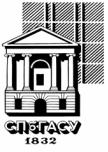
Санкт-Петербургскийгосударственный архитектурно-строительныйуниверситет
Общестроительныйфакультет
Кафедраиностранныхязыков
АНГЛИЙСКИЙ ЯЗЫК
Учебно-методическое пособие № 140
Разговорные темы
Санкт-Петербург
2014
Министерство образования и науки Российской Федерации
Санкт-Петербургский государственный архитектурно-строительный университет
Общестроительный факультет
Кафедра иностранных языков
АНГЛИЙСКИЙ ЯЗЫК
Учебно-методическое пособие № 140
Разговорные темы
Санкт-Петербург
2014
1

УДК378.6:811.111: (076.6)
Рецензент ст. преподаватель В. А. Памфилова (СПбГАСУ)
Английский язык: учеб.-метод. пособие № 140. Разговорные темы / под ред. Л. Я. Лапшиной; сост.: А. С. Глебовский, Л. Р. Данилова, М. А. Сарян, Н. Е. Дубовская, Л. Я. Лапшина, А. В. Потапчук; СПбГАСУ. – СПб., 2014. – 56 с.
Задание содержит экзаменационные разговорные темы, включенные в программу обучения по всем направлениям подготовки (специальностям) и ориентированы по семестрам.
Каждая тема включает сложные слова и выражения, необходимые для полного понимания темы и вопросы для закрепления усвоенного материала.
Предназначено для студентов I–II курсов всех направлений подготовки.
Разговорныетемысоставленыследующимипреподавателями:
Глебовский А.С. – направленияподготовки С, СУЗС, СМ, ЗК,Э,М, ИНН, ПО Данилова Л.Р. – направления подготовки НТТС Сарян М.А. – направления подготовки ЭЭ, ТСБ, ТЭ, ПВ ДубовскаяН.Е. – направления подготовки ЭТМК,ТТП
Потапчук А.В. – направления подготовки А, ДАС, РРАН, Гр, ПМ, ПМИ Лапшина Л.Я. – все направления подготовки
Санкт-Петербургский государственный архитектурно-строительный университет, 2014
ВСЕ НАПРАВЛЕНИЯ ПОДГОТОВКИ (I семестр)
ABOUT MYSELFAND MY STUDY
My name is (…). I am … years old. I was born on (date), (month), (year) in (place of birth). I am interested in obtaining new skills, meeting people,travelling.IhavemanyfriendswhosecompanyIenjoy.Iparticularly enjoy the times when we get together for a walk and for a chat over acoffee.Withthenewsocialmediatoolswefindtimetostayintouchover theInternetandthephone.Visitingtheatres,museums,exhibitions,concerts and places of entertainment is some of good times we have. When I am aloneI likelisteningtomusic,readingorjustrelaxinginfrontof theTV.In fact, there are a lot of things I am fond of doing – going to the cinema, swimming, cycling,playingfootball and tennis, goingtosport events. Life is never boring.
At school I started thinking of my future. Myparents encouraged me tothinkofmyfutureprofession,whichIwouldenjoyandrealizethepotential of myabilities.AtschoolIwasgoodatmathematics,physicsanddrawing. I reallyliked these subjects, so I decided to become an engineer/ architect/ economist/ computer programmer/. Nowadays qualified engineers/ architects/economists/computerprogrammers/areingreatdemandallover the world and are among the best paid professionals. Broad-ranging skills and knowledge are highly valued.
Thus, after leaving secondary school, I entered St.-Petersburg State UniversityofArchitectureandCivilEngineering,whichistheoldesthigher educational establishment of its kind in Russia with a rich history and traditions. The graduates of our university are always in demand in the labourmarket;theymanifestahigh-levelofprofessionalisminconstruction industry and related fields in the new market economy.The University provideseducationforagreatvarietyofprofessionals.Mycourselastsfour years.Istudycivilengineering/architecture/economics/computerprogramming/ logistics/ automobile maintenance/ housing/ industrial construction/ road construction/ road safety/ engineering ecological systems, etc.
Theclassesbeginatnine.Iliveathomewithmyparents/onmyown/ in the hostel/ and it takes me … minutes (an hour) to get to the university. I usually have two lectures and a seminar a day.At the end of each term I must take many tests and four or five exams. I am determined to get good marksandthisrequiresmyfullattention.Mystrategyistoattendallclasses,
2 |
3 |
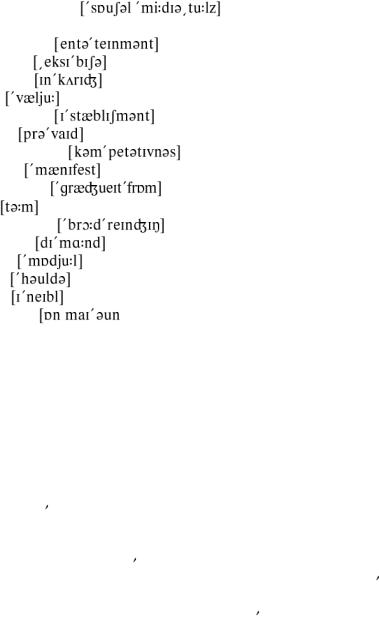
take notes, revise the material at home, use some additional information from books and the Internet. In spite of the fact that I have to study hard I really enjoy being a student.
WhenIgraduatefromtheuniversity,IwillgettheBachelor’sDegree* in civil engineering/ architecture/ economics/ computer programming/ logistics/ automobile maintenance/ housing/ industrial construction/ road construction/ roadsafety/engineeringecologicalsystems.Thatwillenable me to start working in my chosen field, or I may go on studying for two more years and take professional educational courses for getting the Master’s Degree*. This includes special disciplines and modules, which explainnewachievementsinscienceandtechnology.Thecoursesareaimed at scientific creativity, practical and research work. As a Master’s Degree holder, I will have the opportunity to continue my research and to earn PhD* scientific degree which will certainly increase my competitiveness in the labour market and give me the possibility to get an interesting, well paid job in my future profession or perhaps to start my own business.
Notes:
*Bachelor’s Degree – академическая степень бакалавра (диплом бакалавра при поступлении на работу даёт право занять должность, для которой квалификационными требованиями предусмотрено высшее образование).
*Master’s Degree – степень магистра (Магистр – академическая степень, приобретаемая студентом после окончания магистратуры. Магистратура (в некоторых странах называется мастерат)– ступень высшего профессионального образования, следующая после бакалавриата, позволяющая углубить специализацию по определённому профессиональному направлению.
*PhD(DoctorofPhilosophy)Degree–кандидат наук –учёнаястепень первой ступени в Российской Федерации, согласно Международной стандартной классификации образования (МСКО)
ЮНЕСКО2011;например,PhDinTechnicalSciences–кандидат технических наук, PhD (Doctor of Philosophy) также соответствуетстепени докторафилософии взападных странах.
Vocabulary: |
|
– общедоступные средства |
|
social media tools |
|||
коммуникации |
|
|
|
entertainment |
|
n. – развлечение, досуг |
|
exhibition |
|
|
n. – выставка |
encourage |
|
|
v. – способствовать, помогать |
value |
v. – ценить, оценивать |
||
establishment |
|
n. – учреждение, заведение |
|
provide |
|
|
v. – обеспечивать, предоставлять |
competitiveness |
|
n. – конкурентоспособность |
|
manifest |
|
|
v. – служить доказательством |
graduatefrom |
|
v.–окончитьвысшееучебноезаведение |
|
term |
n. – зд. семестр |
||
broad-ranging |
|
– обширный |
|
in demand |
|
|
– пользующийся спросом, востребованный |
module |
|
|
n. – модуль |
holder |
|
n. – обладатель |
|
enable |
|
v. – позволять, давать возможность |
|
on my own |
|
|
] – самостоятельно |
Answer the following questions:
1.How old are you?
2.What are you interested in?
3.How do you like spending your free time?
4.What did your parents encourage you to do?
5.Why did you decide to become an engineer/ architect/ economist/ computer programmer?
6.Which educational establishment did you enter?
7.Why did you enter Saint Petersburg State University ofArchitecture and Civil Engineering?
8.Why isn t it difficult for the graduate of the University to find a job?
9.Which speciality do you study?
10.What does the educational process include?
11.What will the Bachelor s Degree enable you to do?
12.What do professional educational courses for getting the Master s Degree include?
13.What opportunity will you have as a Masters Degree holder?
14.What will increase your competitiveness and give you the possibility to get an interesting and well paid job?
4 |
5 |
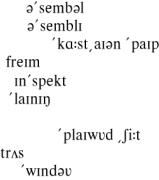
С, ЗК, СУЗС, СМ (II семестр)
BUILDINGMATERIALS
Beforetheconstructionprocessbeginsbasicmaterials,suchaswood, iron, and stone and manufactured products, such as plywood sheets, cast iron pipes, and concrete blocks, must all be determined. Combinations of materials are widely used, such as trusses consisting of glued laminated timbercastironpipewithportlandcementlining,membersincombination withsteelmembers,concretebeamsreinforcedwithprestressedsteelwire, or window and frame units containing glass, several kinds of metal, and plastic all in one assembly.
An assembly is either completely built at the factory (factory assembled)orpartlyproducedatthefactoryandassembledonthesite(site assembled). Some of the types of work that takes place on the site are also manufacturing processes. When concrete is mixed and placed or steel is cut and welded these processes are also called manufacturing.
The builder, like the designer must select, inspect, and test materials which are best suitable for his purpose from among those available.
The types of materials used in buildings have already become standardized. However, new materials are constantly being designed. For example,methodshavebeendevelopedtomakewoodhighlyfireresistant. The development of steel allowed the construction of longer spans than had been possible when wood was the only available material. The development and proper use of new materials require good knowledge of their properties and characteristics.
Vocabulary: |
] v. – собирать, монтировать |
|
assemble [ |
||
assembly [ |
] n. – узел, блок |
|
cast iron pipe [ |
] – чугунная труба |
|
frame [ |
] n. – каркас |
|
inspect [ |
|
] v. – проверять |
lining [ |
] n. – облицовка, обшивка, обделка (термин из области |
|
подземных сооружений) |
||
plywood sheet [ |
] – лист фанеры |
|
truss [ |
] n. – ферма |
|
window [ |
|
] n. – окно |
Answer the following questions:
1.Whichconstructionmaterialsarecalledbasicandmanufacturedones?
2.What kinds of construction assemblies are there?
3.Where arethe assemblies made?
4.Whattypesofworkonthesitecanbecalledmanufacturingprocesses?
5.What must the builder do?
6.What are the examples of new developments in building materials?
6 |
7 |
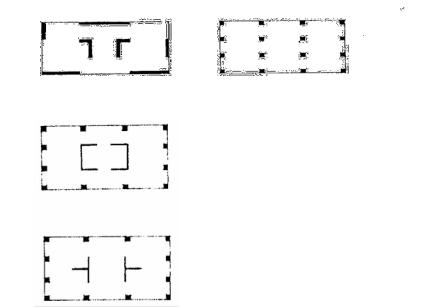
С, ЗК, СУЗС, СМ (III семестр)
SHEAR WALLAND FRAME SYSTEMS
In general the structural system used for medium-rise or high-rise buildings is a choice, in one form or another, between loadbearing wall systems, also knownas shear wall systems, and frame systems.Frame and shear wall systems may be combined in the same building. Aloadbearing wall is one used to carry gravityload but is known as a shearwall if it also transfers horizontal forces to ground.
Whateverstructuralsystemisused,itmustbeabletocarrythevertical loads caused by gravity forces, and the horizontal loads caused by wind andearthquake forces.Earthquakes maycauseadditionalverticalforcesto act on the structure but damage is most likely to occur as a result of the horizontal forces on the buildingdue to earthquakes.The horizontal forces are extremely important in the design of high rise buildings.
High risebuildings arethose forwhich the scaleeffect of an increase inheighthasa significantinfluenceonthestructuraldesign.Ingeneralthis scaleeffectisconnectedwithbuildingsaboveabouttwentystoreysinheight for which the ratio of height to least horizontal dimension is greater than five.Asbuildingsincreaseinheight,moreefficientwaysofprovidinglateral stiffness are necessary to control horizontal movement and these can have a significant influence on the form.
Medium rise buildings may be said to include buildings which are lowerthanhigh-risebuildingsbutstillmorethanaboutfivestoreysinheight.
Vocabulary:
efficient [
 ] a. – эффективный
] a. – эффективный
medium-rise building [

 ] – здание средней этажности
] – здание средней этажности
scale effect [
 ] – влияние масштаба whatever [
] – влияние масштаба whatever [
 ] pron. – какой бы ни
] pron. – какой бы ни
Answer the following questions:
1.What is the structural system used for medium-rise or high-rise buildings?
2.What is the difference between a loadbearing wall and a shear wall?
3.What must a structural system be able to do?
4.Why are the horizontal forces important in the design of high rise buildings?
5.When do more efficient ways of providing lateral stiffness become necessary?
6.What buildings are said to be medium-rise ones?
Plans of buildings stabilised by shear walls, left, and by frames, right
Plans of buildings with frames and shear walls
8 |
9 |
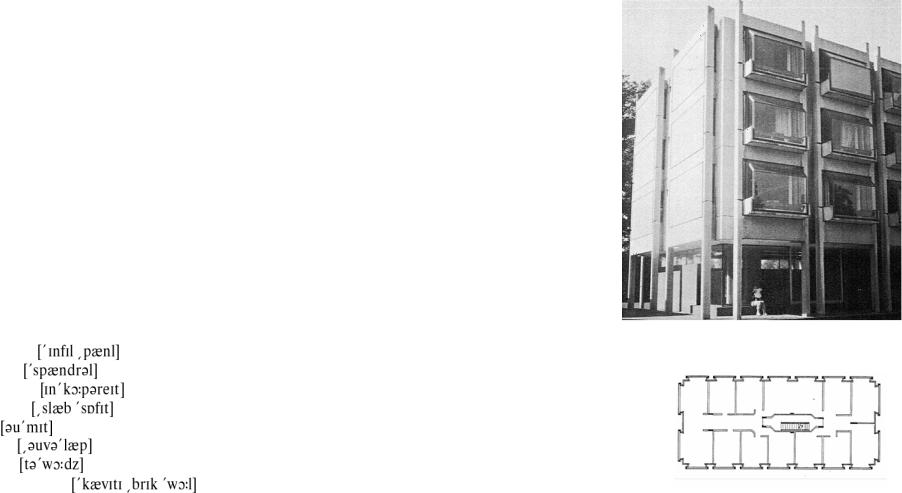
С, ЗК, СУЗС, СМ (IVсеместр)
BOULTON HOUSE, CAMBRIDGE, ENGLAND
This is a residential building containing bedrooms for students. The building structure consists of 18 precast concrete H-frames around the perimeter and 9 interior cast-in-place concrete columns, all supporting a heavy deep concrete slab at each floor level. The building foundations are piled, all precast columns being positioned in 2 ft deep pockets in ground beams sitting on the piles.There are precast concrete infill panels between butset behindthe H-frames,andthese panels overlapon the columns each side. Infill panels are also used at right angles to the H-frames, having the same height as the spandrel of the H-frames.
All infill panels on the east and west sides as well as corner panels andthelargewallpanelsonthenorthandsouthsidesincorporateinsulation.
The ground floor is set back from the perimeter and enclosed by a cavity brick wall. Inside, the ground floor has a suspended ceiling below theslabsoffit,thevoidcontainingserviceswhichthenpassupwardsthrough holes in the floor slabs.
Internal columnsaremostlyatabout11ft centres; theyare omittedat oneplacewherethe slabhas to spanabout 22 ft. Eachfloorslab carriesthe loads at that level, including the partition walls between bedrooms. Horizontal forces are taken by frame action.
Precastelementsweremadeinwoodenformsusingwhiteaggregates and white cement. The spandrel of the H-frame has its top sloped back towards the buildingsothat rainwatercanbe ledbackbehindthe columns.
Vocabulary: |
|
|
infill panel |
|
– панель стенового заполнения |
spandrel |
|
n. – пазуха свода |
incorporate |
|
v. – включать |
slab soffit |
|
– нижняя поверхность плиты |
omit |
v. – пропускать, не включать |
|
overlap |
|
v. – перекрывать, заходить один за другой |
towards |
|
prep. – к, около, по отношению к |
cavity brick wall |
– cтена из пустотелого кирпича |
|
|
|
10 |
Answer the following questions:
1.What does the building structure consist of?
2.What kind of foundation does the building have?
3.Which panels incorporate insulation?
4.What does the ground floor structure feature?
5.Where are the internal columns omitted?
6.Why does the spandrel of the H-frame have its top sloped back towards the building?
View of the building
Typical floor plan
11
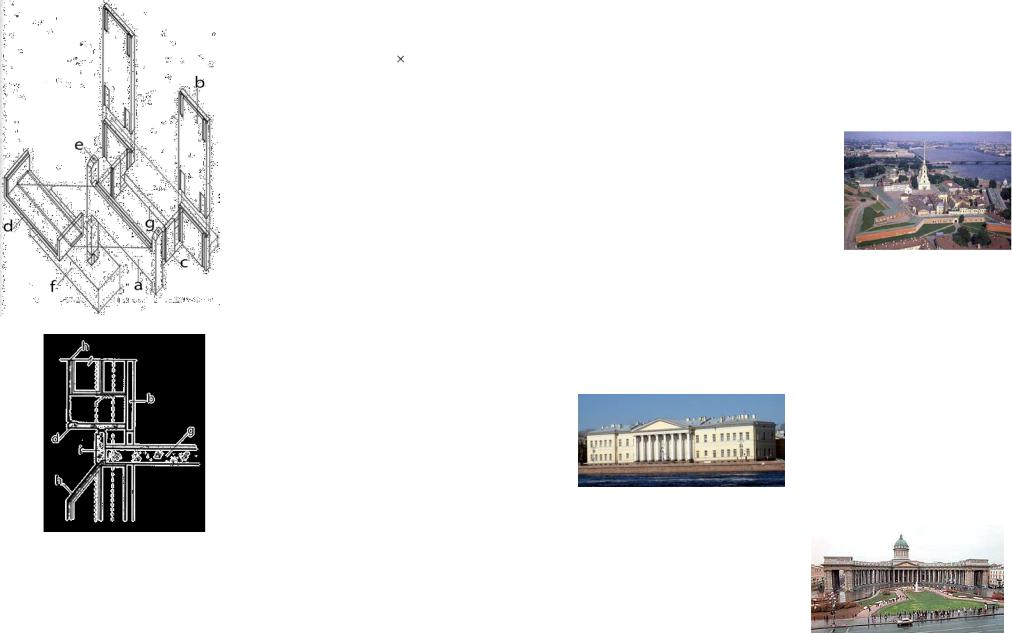
Assembly of elements at floor above ground level
a precast concrete H-frame with 2'–6" deep spandrel beam and 6¼" 11¼" columns;
b 5" infill panel;
с 5" spandrel height infill panel; d precast concrete window seat;
e 23/8 "steel tube to receive lifting bolt for erection and 1" dowel bars from frameabovewithmetalshimsandmortar in final condition;
f 3'-0" square section concrete ground beam with slots;
g 9" cast-in-place floor slab.
Vertical section through typical upper floor
h aluminium window frame with opening light;
i precast concrete H-frame with 1'–8" deep spandrel beam and 6¼"
 11¼"
11¼"
columns.
А, РРАН, ДАС, Гр (II семестр)
SAINTPETERSBURG
18th Century
St Petersburg is one of the cities in the world built according to conceived scheme. In 1716 the French architect Jean-Baptiste Le Blond createdthegenerallayoutfortheconstructionofStPetersburgandafterhis death the work in accordance with this plan
started under supervision of the Swiss architect DomenicoTrezzini.
Thefirststructureofthefuturecitywas the Peter and Paul Fortress. Peter the Great himself made a suggestion on the overall schemeofthefortress.Trezzinidesignedthe stone Peter and Paul Cathedral in 1712 on
the site of a wooden church. Soon the entire fortress took the cathedral’s name.ThecathedralisthemostimportantexampleofthePetrineBaroque.
During the reign of Elizabeth, the daughter of Peter the First, Saint Petersburg changed its appearance beyond recognition and turned into a splendidcityofluxuriouspalacesdesignedintheBaroquestyle.Francesco Rastrelliwasthemostoutstandingarchitectofthattime.Hisgreatestcreation was the Winter Palace.
TheBaroquewasdisplacedby Neo-Classicism during the reign of Catherine the Great. Its typical examplesaretheTauridePalacebuilt by the Russian architect Ivan Starov and the projects carried out by the
Italian Giacomo Quarenghi (Smolny Institute, Hermitage Theatre, the Academy of Science and others).
19th Century
That century began with the construction of the Kazan Cathedral (1801–1811) when the Empire style of Late Classicism was predominant.The
Russian architectAndrey Voronikhin, a former serf, made the Cathedral’s project.
12 |
13 |
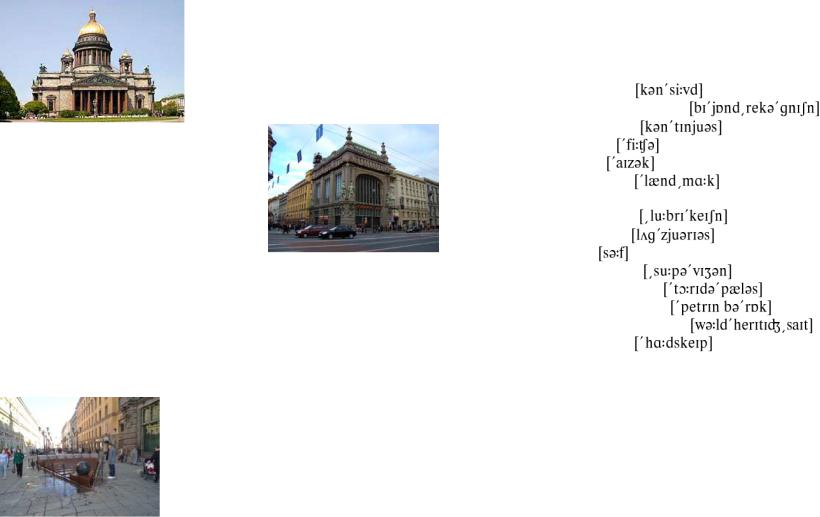
Themostimpressivelandmarkwastheensembleofthreelargesquares– Palace square, St Isaac’s square and Senate square. The appearance of this part of the city reflects the traditions of urban construction formed in the eighteenth and early nineteenth centuries – the principles of “remarkable buildings”,“regularsquares”,and“continuouslinkingofstreets”.Thefocal element of the complex of the three squares is the Admiralty created by Andreyan Zakharov.
StIsaac’s Cathedralwasdesignedbythe FrencharchitectAuguste de Montferrand and consecrated to St Isaac of Dalmatia, whose name-day coincides with the birthday of Peter the Great.
Drawbridges spanned the Neva, streets were paved with stone; at the end of the nineteenth century electric lamps illuminated the streets.
20th Century
By that time Art Nouveau broke into the city’s architectural silhouette. The Yeliseyev Brothers Trade House (1900– 1903)wasbuiltinstone,concreteandglass. Ithasmanyimpressivedetails:ahugeglazed surface of the façade, a large stained glass
window, heavystone facingandnaturalisticsculptureornamentstypicalof theArt Nouveau style.
Towards the beginning of the 20th century Nevsky Prospect was occupiedbybusinesspeople,forwhomhugebuildingsofbanks,tradehouses and company offices were built. One of such structures was put up for the Americancompany(Singers & Co)knownformanyyears asthe House of Books (1902–1904).
21stCentury
Present-day architects continue improvinganddecoratingNevskyProspect.In recent years pedestrian friendly zones were createdinMalayaKoniushennayaandMalaya Sadovaya Streets running from Nevsky Prospect. Malaya Sadovaya Street was paved
with tiles, the street separation and sidewalk were removed, a fountain featuring a Kugel ball (a heavy stone ball easily rotatable because of lubrication by the fountain’s water) was built. Later new monuments and hardscape were installed there.
Saint Petersburg is often described as the most Westernized city of Russia,aswellasitsculturalcapital.Itisthenorthernmostcityintheworld havingthepopulationofoveronemillion.Sincearoundtheendofthe20th century a great deal of active building and restoration works have been carried out in a number of the city’s districts. The Historic Centre of Saint PetersburgandRelatedGroupsofMonumentsconstituteaUNESCOWorld Heritage Site.
Vocabulary: |
|
|
|
|
|||||
conceived |
|
|
|
|
a. – задуманный |
||||
beyond recognition |
|
|
– до неузнаваемости |
||||||
continuous |
|
a. |
– непрерывный |
||||||
feature |
|
|
v. |
– характеризоваться, отличаться |
|||||
Isaac |
|
|
Исаак |
|
|
|
|
||
landmark |
|
|
|
|
|
n. – достопримечательность, архитектурный |
|||
памятник |
|
|
|
|
|
|
|
|
|
lubrication |
|
n. – смазка |
|||||||
luxurious |
|
|
|
|
a. – роскошный |
||||
serf |
|
n. |
– крепостной |
||||||
supervision |
|
|
|
n. – наблюдение |
|||||
Tauride Palace |
|
|
– Таврический дворец |
||||||
Petrine Baroque |
|
|
– Петровское барокко |
||||||
World Heritage Site |
|
|
– объектвсемирного наследия |
|
|||||
hardscape |
|
|
|
|
n. – малые архитектурные формы |
|
|||
Answer the following questions:
1.What is the main feature of the construction of Saint Petersburg?
2.Who created the first general layout of Saint Petersburg?
3.Whatwasthefirststructureofthefuturecityandwhomadeasuggestion on the overall scheme of this structure?
4.What structure did DomenicoTrezzini design?
5.WhatwasthefirstpredominantarchitecturalstyleinSaintPetersburg?
6.Who was the most outstanding architect during the reign of Elizabeth and in what architectural style did he create his luxurious palaces?
14 |
15 |
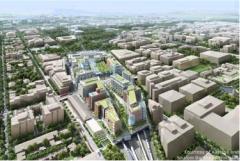
7.What architectural style replaced the Baroque? Give the examples of the structures built in accordance with this new style.
8.What two remarkable cathedrals were constructed in the 19th century?
9.Whatwasthemostimpressivelandmarkof SaintPetersburginthe19th century?
10.What architectural style prevailed in the 19th century?
11.What architectural style was developed during the construction of the Yeliseyev Brothers Trade House and the House of Books?
12.How do present – day architects improve and decorate the centre of Saint Petersburg?
13.What architectural value do the Historic Centre of Saint Petersburg and Related Groups of Monuments constitute?
А, РРАН, ДАС, Гр (III семестр)
URBAN DESIGN
Urbandesigninvolvesthe arrangement and design of buildings, public spaces, transport systems and services. Urban design is the process of giving form and character togroupsofbuildings,towhole neighborhoods, and the city. Itisaframeworkthatordersthe elements into a network of streets, squares, and blocks.
Urbandesignblendsarchitecture,landscapearchitecture,andcityplanning together to make urban areas functional and attractive.
Urban design includes the following elements:
1.Buildings are the most pronounced elements of urban design – they shape and articulate space by formingthe street walls of the city.
2.Greatpublicspacesaretheplaceswherepeoplecometogethertoenjoy the city and each other. Public spaces make possible high quality life in the city.
3.Streets are the connections between spaces and places, and are spaces themselves.Theyaredefinedbytheirphysicaldimensionandcharacter aswellasthesize,scale,andcharacterofthebuildingsthatline them.
4.Transport systems connect the parts of cities, help to shape them, and enablemovementthroughoutthecity. Theyincluderoad,rail,bicycle, and pedestrian networks, and form the total movement system of a city.The bestcities are the ones thatelevate the experienceof the pedestrian minimizing the dominance of the private automobile.
5.The landscape is the greenpart of the citythat weaves throughout – in theformofurbanparks,streettrees,plants,flowers,andwaterinmany forms. The landscape defines the character and beauty of a city and creates soft or contrasting spaces and elements.
16 |
17 |
